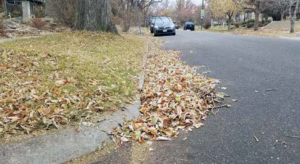“Lakespert” – “Lakespert” becomes “Lawnspert”!
Steve Lundt, CLM
Fertilizing your lawn in the fall can protect your lake in the spring

Fall is an important time when it comes to phosphorus – for lawns and lakes. Photo: Steven Lundt.
“Lakespert” becomes “Lawnspert” (second coined term). Here in Colorado, I have been steadily working on a state-wide phosphorus-free lawn fertilizer initiative (minus legislation). This phosphorus prevention effort has taught me a few things about lawns and fertilizing that I would like to share.
Starting with the Four R’s – Right Place, Right Time, Right Product, and Right Rate. This mnemonic device helps people, that use fertilizers, think about the connections between their individual actions and collective impacts downstream.
Right Place – Keep it on the lawn and away from storm water. I have quickly realized that most folks do not understand storm drains or where the water goes. For Colorado and many places, storm water is not treated but people still use them like ground-level garbage cans.
Right Product – A soil test is key to understanding what lawn fertilizer you need. From lawn starters to all-purpose, fertilizer companies have developed many different variations of N:P:K (nitrogen: phosphorus: potassium) ratios for lawns. If you don’t need phosphorus, then use non-phosphorus lawn fertilizers.
Right Rate – This one is tricky and requires math skills. The first step is for a lawn owner to know their lawn surface area. Application rates are based on nitrogen amount per 1,000 square feet of lawn for a growing season. Next step is knowing the initial weight of the fertilizer bag and calculating the mass of nitrogen in it. The proper rate is based on knowing the lawn area, the percent of nitrogen in your fertilizer, calculating how much to apply for each application, and then making sure your method of spreading delivers the right amount.
Right Time – Most lawn owners focus their fertilizing on the spring. It is best to fertilize in the fall to be ready for the spring. It is best to apply three or four times while avoiding the hottest time of the summer for cool-weather grasses. It is key to avoid applying before, during, and after storm events and never when the ground is frozen. Timing can be everything.
These steps and decisions seem relatively simple, but I still finding it surprising how little lawn owners really know about fertilizing and the impacts to downstream waters. As I continue this effort to educate Colorado lawn owners, I keep reminding myself that people want to do the right thing for our lakes and streams. Mulch your clippings. Rake your leaves for composting (not into the street). Fertilize thoughtfully this fall to help protect your lake in 2022.
 Steve Lundt, Certified Lake Manager, has monitored and worked to improve water quality at Barr Lake (Denver, Colorado) for the past 19 years. Steve is active with the Colorado Lake & Reservoir Management Association and is a past Region 8 director for NALMS and an active member since 1998.
Steve Lundt, Certified Lake Manager, has monitored and worked to improve water quality at Barr Lake (Denver, Colorado) for the past 19 years. Steve is active with the Colorado Lake & Reservoir Management Association and is a past Region 8 director for NALMS and an active member since 1998.

